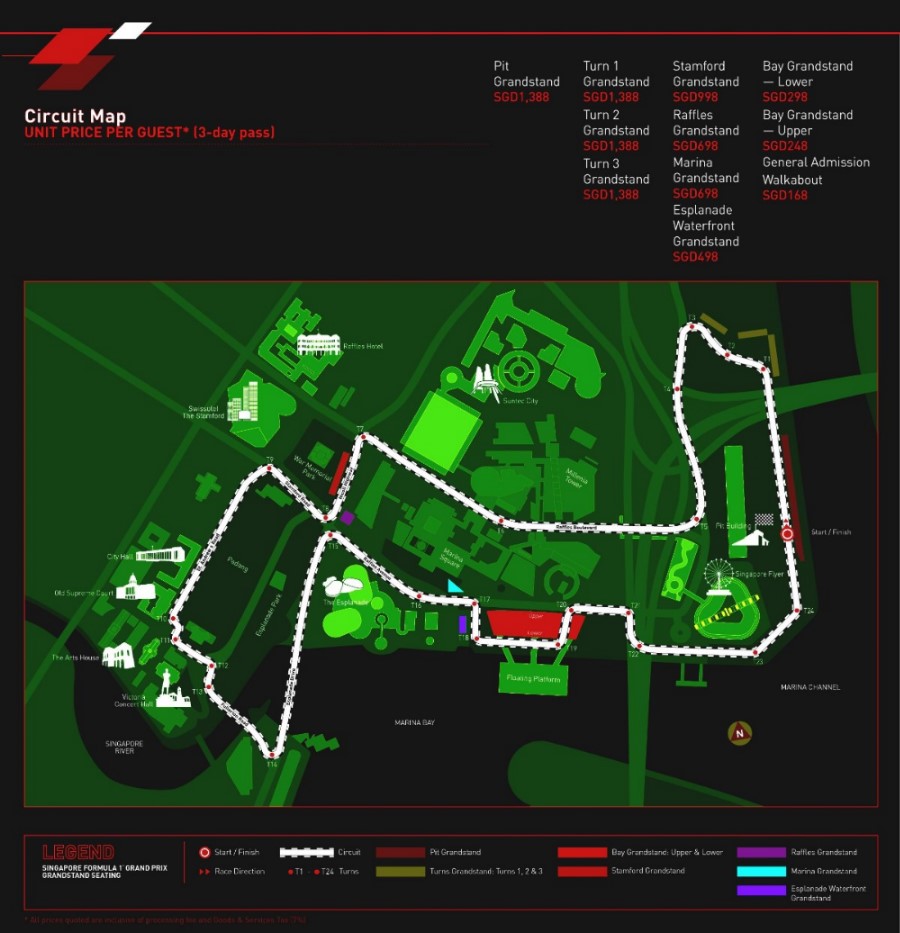A flying lap of the Singapore street circuit
 |
| Singapore street circuit |
No-one, of course, has yet driven the track which will host the FORMULA 1 SingTel Singapore Grand Prix. Based on speed projections and simulations, ESPN Star Sports commentator Steve Slater and former F1 driver and Clerk of the Course Tim Schenken have put their heads together to create a ‘virtual’ flying lap.
TURN 1. Maximum rate braking from over 280km/h down to about 90, being careful to control wheel locking as the driver downshifts from 7th gear to 2nd for the tight left hander. A great place to see the awesome braking power of an F1 car. It’s also a good opportunity for a following car to grab a ‘sneak’ move down the inside and take a place.
TURNS 2/3/4 Briefly up to 3rd gear and 160km/h through Turn 2, before dropping back to second gear for the 90km/h Turn 3. Then it’s back onto full throttle and up to 4th gear and 200km/h as the cars leave the permanent section of the track and flick through Turn 4, the first corner on the public highway.
TURN 5 Back onto the brakes and down to 3rd gear for Turn 5, the entrance to Raffles Boulevard. The exit to this corner, taken at about 140km/h, has an opening radius which will allow a car following closely, not to lose too much downforce. That gives an opportunity for an overtaking move at the end of the straight.
TURN 6 Before that though, we reach the awesome Turn 6, a flat-out, full throttle kink in the track taken just before the cars change from 6th to 7th gear. Just after this corner is the fastest section of the track where the cars reach 310km/h, with the screaming exhaust notes bouncing off the surrounding buildings. Turn 6 will be the fastest corner on any street-circuit ever!
TURN 7/8. At the end of Raffles Boulevard, Turn 7 is potentially one of the best overtaking opportunities. Here the cars brake from over 300km/h down to 90km/h for the second gear left-hander onto the Nicholl Highway, briefly accelerating back up to 200km/h in third before taking the 2nd gear right-hander around the War Memorial and accelerating to 200km/h along the short stretch of Stamford Road. The grandstands at Turn 8 could be one of the best viewing locations. If you get the right seat you’ll also see the cars as they return over the Esplanade Bridge to Turn 15!
TURN 9 A clean exit from the 3rd gear left hander at Turn 9, will control the cars speed along Anderson Road and past the Padang sports fields. It too is an opening radius corner – and without electronic traction control – the driver who can best control his cars horsepower will have an advantage at the end of the straight.
TURNS 10-14 From over 250km/h the cars will brake hard, again giving an overtaking opportunity, for the slower sequence of corners at the end of the straight. The heritage buildings of the old Supreme Court and the Singapore Cricket Club will create a backdrop similar to Monaco’s Casino Square.
Here the drivers balance the cars in 2nd and 3rd gears at between 100 and 160 km/h, as they line up to cross the Anderson Bridge, a unique feature of any track in the world. Built in 1910 to link the North and South Banks of the Singapore River, its colonial architecture marks a major contrast to the ultra-modern skyline of the business quarter just behind.
TURNS 15/16 After a tight second gear hairpin at Turn 14, the cars will reach over 280km/h in seventh gear as they cross the Esplanade Bridge, before braking hard and shifting down to 2nd for the right handed Turn 15. This offers another overtaking opportunity before the cars accelerate back up to 240km/h through Turn 16, before reaching the slow speed section of track around the National Day Grandstand.
TURNS 17-20 The slowest part of the circuit taken at around 100km/h in 2nd gear, still provides a challenge to drivers and engineers. This section of track will work the brakes hard and place a premium on slow speed traction, not to mention the driver’s finesse! After running along the waterfront in front of the giant 27,000 seat grandstand, at Turn 19 the cars actually turn beneath the grandstand itself – another unique feature of the FORMULA 1 SingTel Singapore Grand Prix.
TURNS 21-24. Two further slower turns taken at around 120km/h in 3rd gear bring the cars back onto the waterfront next to the Singapore Flyer, the world’s largest observation wheel. The final two turns, taken at 150km/h and 200km/h respectively, give a fast flowing end to the lap with 5.067km, 14 left turns and 10 right turns completed.
